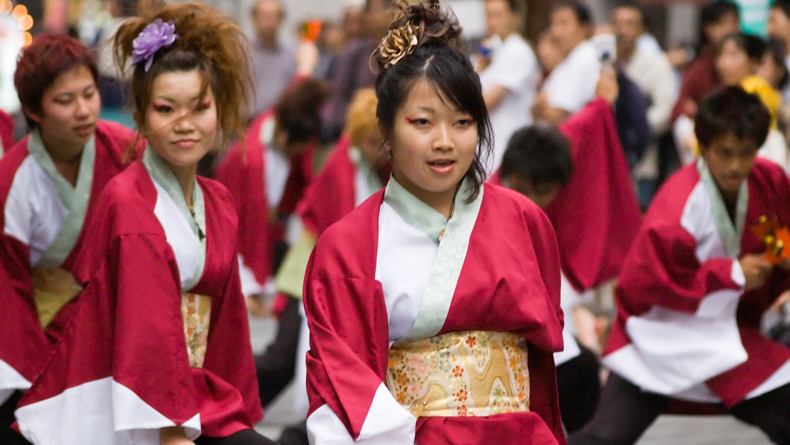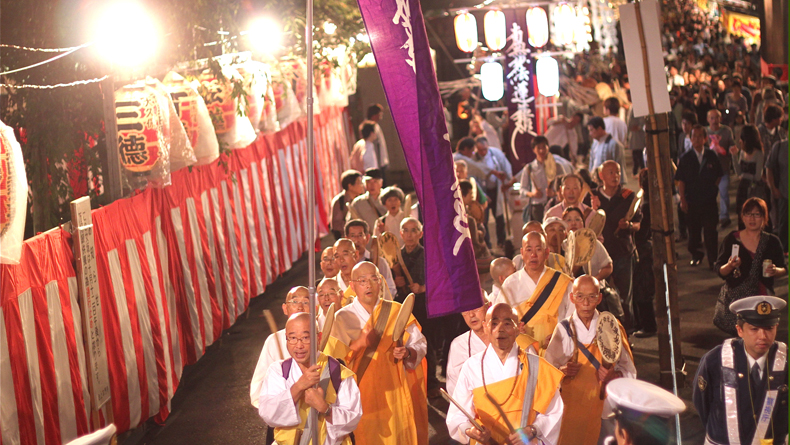Matsuri Madness: Autumn 2013
Although summer is officially over, the myriad of festivals occurring in and around Tokyo hasn’t diminished. In fact, the new season brings with it a number of new reasons to celebrate.
September
Kitazawa Hachiman Shrine Matsuri, Daizawa, Tokyo, September 7-8, All Day
Getting There: 10-minute walk from Shimokitazawa Station, Inokashira and Odakyu Lines
The largest Shinto shrine in Tokyo’s Setagaya ward, Kitazawa Hachiman, hosts this incredible mikoshi matsuri (portable shrine festival) each year. While kagura (Shinto music and dance) will be performed from 3 p.m. on Saturday, it’s Sunday’s activities that will draw the biggest crowds. From 1 to 2:30 p.m., over 20 mikoshi enter the Hachiman Shrine. Watching this enthusiastic procession is quite a sight to behold.
Akasaka Hikawa Matsuri, Akasaka, Tokyo, September 13-15, 12-9 p.m.
Getting There: Akasaka Station, Chiyoda Subway Line
This festival is the biggest event each year for the Akasaka Hikawa Shrine, and because of its location it has a fantastic community feel to it. With the festival hallmark street stalls and activities, there’s a lot of entertainment provided. From 7 p.m. on Friday evening, a mikoshi parade takes place, and on Saturday from 1:30 p.m., a children’s mikoshi parade starts at Akasaka Shogakko. The main procession of sansha—a type of giant float—begins at midday on Sunday from three different points, before joining up at Akasaka Station, and then proceeding altogether to the shrine.
Kichijoji Aki Matsuri, Musashino Hachimangu Shrine, Kichijoji, Tokyo, September 14-15, from 11 a.m.
Getting There: Kichijoji Station, JR Chuo Line
Kichijoji’s annual autumn festival is the biggest event on the neighborhood’s calendar. The mikoshi procession kicks off at 11 a.m. on Saturday, and leaves the shrine to parade through the area’s districts. But the highlight of the festival is Sunday, when the mikoshi come out in force from 3 p.m., starting on Heiwa-dori in front of Kichijoji Station, causing some serious excitement. With the festival stalls selling food, drinks and souvenirs, it is easy to get into the festival spirit.
Tokugawa Hundred-Member Gun Squad Fair, Kaichu Inari Shrine, Hyakunincho, Tokyo, September 22, from 10 a.m.
Getting There: 2-minute walk from Shin-Okubo Station, JR Yamanote Line
Held every odd year, Teppo-gumi hyakunin-tai, or the Hundred-Member Gun Squad, has its origins rooted in what was then the newly established capital of Edo. Founded by Tokugawa Ieyasu to defend his shogunate, the squad was stationed in Hyakunincho (meaning ‘hundred-member town’), Shinjuku—an area specifically named in the crew’s honor. The shooting demonstration begins at the shrine from 10 a.m. The course the group follows has them parading through Okubo-dori, Otakibashi-dori, Shokuan-dori, Nishi-Toyama Elementary School, Hyakunincho 3-chome, and Nishi-Toyama-Koen, before heading back to the Shrine at 2:10 p.m.
Ohara Hadaka Matsuri, Kaisuiyokujo Beach, Ohara, Chiba, September 22-23, from 1 p.m.
Getting There: 20-minute walk from Ohara Station, JR Sotobo Line
For a festival with a difference, head to the Chiba coastline and witness what is otherwise known as the Naked Matsuri. From 2:30 p.m. onwards, 18 mikoshi are carried by thousands of semi-naked men into the sea. A purification ritual, known as shiofumi, follows, with the men shaking and sometimes submerging the mikoshi, and there is every chance a few of those modest coverings come away during this somewhat arduous task! As is the way with all good matsuri, the mikoshi are of course paraded through the streets upon finishing the cleansing ceremony, until 10 p.m.
Fukuro Matsuri, Ikebukuro, Tokyo, September 28-29, 1-8 p.m.
Getting There: West Exit of Ikebukuro Station, JR Yamanote Line
Commencing in 1968 as a commercial venture to promote four shopping areas on the west side of Ikebukuro Station, the Fukuro Festival is now one of the biggest events of the area. The modern day festival has evolved to include all of Ikebukuro. While it seems no Japanese matsuri would be complete without some sort of mikoshi procession, this celebration also has a number of other events to see, such as an array of dance displays, taiko drum shows, and festival music.
October
Oeshiki Festival, Ikegami Honmonji Temple, Ota-ku, October 11-13, 6-11 p.m.
Getting There: 10-minute walk from Ikegami Station, Tokyu Ikegami Line, or 8-minute walk from Nishimagome Station, Toei Subway Asakusa Line
Each year, around 300,000 people attend this Buddhist festival spectacular, honoring the anniversary of Saint Nichiren’s death. Although it’s celebrated in many places around Japan, the Ikegami Honmonji Temple event is the most prominent, being the actual place of the saint’s passing. The mando rite, which involves 3,000 people carrying sacred lanterns along the two-kilometer route from Ikegami Station to the temple, is truly a sight to behold and by far the festival highlight. With the festival being over 730 years old, this temple really brings it into the modern day by broadcasting the mando rite and Rinmetsudoji Hoyo (Buddhist sermon) over the internet.
Tsukiji Fish Market Autumn Festival, Tsukiji, October 12-13, 9 a.m.-3 p.m.
Getting There: Short walk from Tsukiji Station, Hibiya Line or Tsukijishijo Station, Toei Oedo Line
Get your fill of fish without the early start! Head down to the world famous fish market and check out the matsuri madness on an oceanic scale. This is definitely an event to take the family to, with Sunday being specifically for children…not sure what that means, but it will be nice to wander around the market without fear of losing your life to one of those little trolleys the fisherman zoom around on.
Tokyo Grand Tea Ceremony, Hamarikyu Gardens, October 12-13, 9:30 a.m.-4:30 p.m.
Getting There: 7-minute walk from Shiodome Station, Tsukijishijo Station or Yurikamome Shiodome Station, Toei Oedo Line or 10-minute walk from Shimbashi Station, Tokyo Metro Ginza/Toei Asakusa Lines
Be a part of the welcoming spirit of hospitality, and be introduced to the art of the Japanese tea ceremony of the Edo period. This is a brilliant way to experience this beautiful tradition and the event brings together a range of people—locals, expats, and tourists of all ages—taking advantage of this unique opportunity to come into contact with sado, a tea ceremony art encompassing landscape, tools and decorum, with an fundamental aesthetic that focuses on the spirit of hospitality towards the guests. For more information, please check the event website.
Takadanobaba Yabusame, Ana Hachimangu Shrine, Toyama Park Hakoneyama Area , October 14, 2-3:30 p.m.
Getting There: Short walk from Waseda Station, Tozai Subway Line
Witness some spectacular displays of yabusame, or horseback archery, a traditional Japanese practice. It involves highly skilled riders shooting arrows at targets whilst riding galloping horses. Leaving the Ana Hachimangu Shrine, the yabusame procession will then make its way to Toyoma Park, where the action will take place.
Marunouchi Nakadori Gardening Show 2013, Marunouchi Nakadori Street, Chiyoda-ku, October 18-31, 9:30 a.m.-8 p.m.
Getting There: Short walk from Short walk from JR Yurakucho/Tokyo stations, Tokyo Metro Hibiya/Nijubashimae/Tokyo/Yurakucho stations, Toei Subway Hibiya/Otemachi stations
With the delightful sounding “Happiness Garden—Sharing Happiness With You” theme, 2013 celebrates the 10th anniversary of the Marunouchi Nakadori Gardening show. One of Japan’s few urban gardening exhibitions, it’s well worth a look, particularly for something different from the usual matsuri offering up a stack of street vendors and a quirky temple ritual. As a special event, 2013 will see the previous years’ garden installation winners competing against each other, with the installations displayed along the avenue. For more information on the event, please visit the official site.
Nihonbashi Ebisuko Bettaraichi (Pickle Fair), Takarada Ebisu Jinja Shrine, Nihonbashi, October 19-20
Getting There: Short walk from Kodenmacho Station, Hibiya Subway Line
This is a popular community event that can trace its origins back to the middle of the Edo period. In preparation for the Ebisuko Ceremony honoring the god Ebisu that occurs on October 20, business-savvy merchants began to sell offering and ceremonial supplies outside the shrine on the previous day, October 19. Nowadays, as the name may have given away, this celebration is well known for the many of vendors selling bettarazuke, a sweet and salty daikon radish pickle. Over the fair’s two days, the area becomes alive with stalls, sights, and sounds.
Kiba no Kakunori (Kiba Square Log Rolling), 30th Koto City Residents’ Festival, Kiba Park Event Pond, Koto-ku, October 20
Getting There: 5-minute walk from Kiba Station, Tozai Subway Line
If you’re looking for a quirky festival experience, then this one’s for you! This interesting event occurs as part of the Koto City Residents’ Festival. Given that the area of Kiba means lumberyard in Japanese and was once teeming with them, it comes as no surprise that the Japanese have managed to evolve kiba no kakunori, or square log rolling, into a specialized folk art, inspired by the process of building rafts for transport, in which the lumberyard workers would maneuver enormous logs with only a single fire hook. This annual event is organized in order to pass down both the origin of the name and traditional culture of the area.
Fureai Festa, Toyama Park, Okubo Area, October 20, 10 a.m.-4 p.m.
Getting There: 3-minute walk from Nishi-Waseda Station, Fukutoshin Subway Line; 10-minute from Takadanobaba Station, JR Yamanote Line/Seibu-Shinjuku Line; or a 15-minute walk from JR Shin-Okubo Station
Set up over three stages in Toyama Park, this annual festival is comprised of many performances and exhibitions including dancing, taiko drumming, jazz, wind instruments, and folk art. Along with the musical extravaganza, expect to find an abundance of vendors offering up everything from traditional games to local delicacies. There is even a mini zoo, disaster prevention corner, and a healthcare corner—although I am unsure how the latter two fit into the festive spirit of the matsuri.
Kanda Used Book Festival, Yasukuni Street (between the Surugadaishita and Sendaimae intersections), Jimbocho, October 26, 10 a.m.-7 p.m.
Getting There: Jimbocho Antique Book District, Kanda, short walk from Jimbocho Station, Tokyo Metro/Toei Subway Line
It’s not unusual for the Japanese to celebrate…everything! And since Jimbocho is marked on the map as the place to go for used and antique books, it’s no wonder that the Kanda Used Book Festival has sprung to life to become the biggest event of the year in this district. For the festival’s duration, bookshelves are placed on the sidewalks of the main avenue of Yasukuni Street, creating a long corridor of books that faces the local bookstores. A variety of sales and events are scheduled throughout the festival. You can even organize for any purchases to be shipped to your home.
Photos by Elmimmo and Tenaciousme.














Leave a Reply